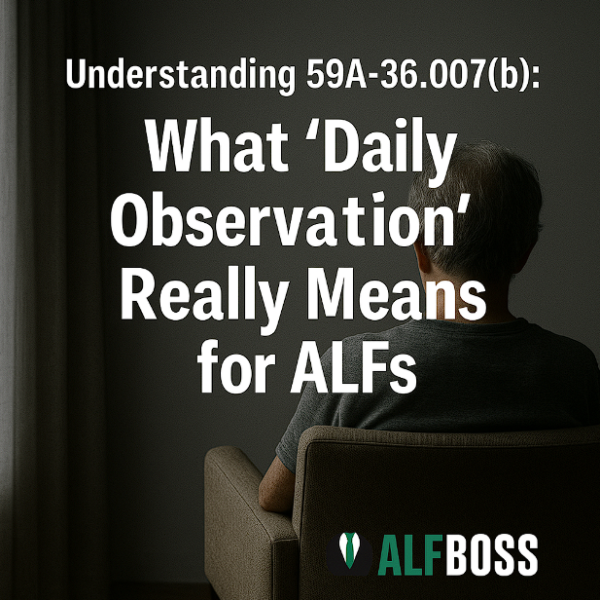
Understanding 59A-36.007(b): What “Daily Observation” Really Means for ALFs
Regulation Overview:
59A-36.007 Resident Care Standards
(b) Daily observation by designated staff of the activities of the resident while on the premises, and awareness of the general health, safety, and physical and emotional well-being of the resident.
At first glance, this part of the regulation seems straightforward. But in practice, it places broad responsibility on staff to be actively engaged in resident care and aware of changes that could indicate a problem.
Below is a breakdown of what “daily observation” and “awareness” might include:
Possible Areas of Observation:
Physical Health
- Changes in walking, posture, or balance
- Unexplained bruising or skin issues
- Appetite changes or weight loss
- Pain symptoms or complaints
- Unusual fatigue or weakness
Emotional and Mental Well-being
- Signs of depression or withdrawal
- Agitation or mood swings
- Confusion or memory issues
- Expressions of loneliness or fear
General Safety
- Cluttered or unsafe environment around the resident
- Wearing inappropriate footwear or clothing
- Medication compliance and any missed doses
- Unsafe behaviors (wandering, entering others’ rooms)
Engagement and Activity
- Lack of participation in routine activities
- Drastic change in social behavior
- Remaining in bed most of the day without cause
Tips to Stay Compliant:
- Train staff to look beyond the obvious. Observation isn’t just visual — it involves listening and checking in with residents throughout the day.
- Document daily observations if there’s any change in condition or behavior — even small shifts.
- Ensure staff know what to do if they notice something off, including notifying supervisors or healthcare professionals.
- Regularly review incident logs and care notes to ensure issues aren’t being missed or patterns overlooked.
- Create a culture of attentiveness, where all staff — not just caregivers — understand the importance of daily observation.
Bottom Line:
59A-36.007(2)(b) is a catch-all that covers health, safety, and emotional needs. A facility that fails to observe and respond to resident changes risks non-compliance — but more importantly, it risks the well-being of the people in its care.